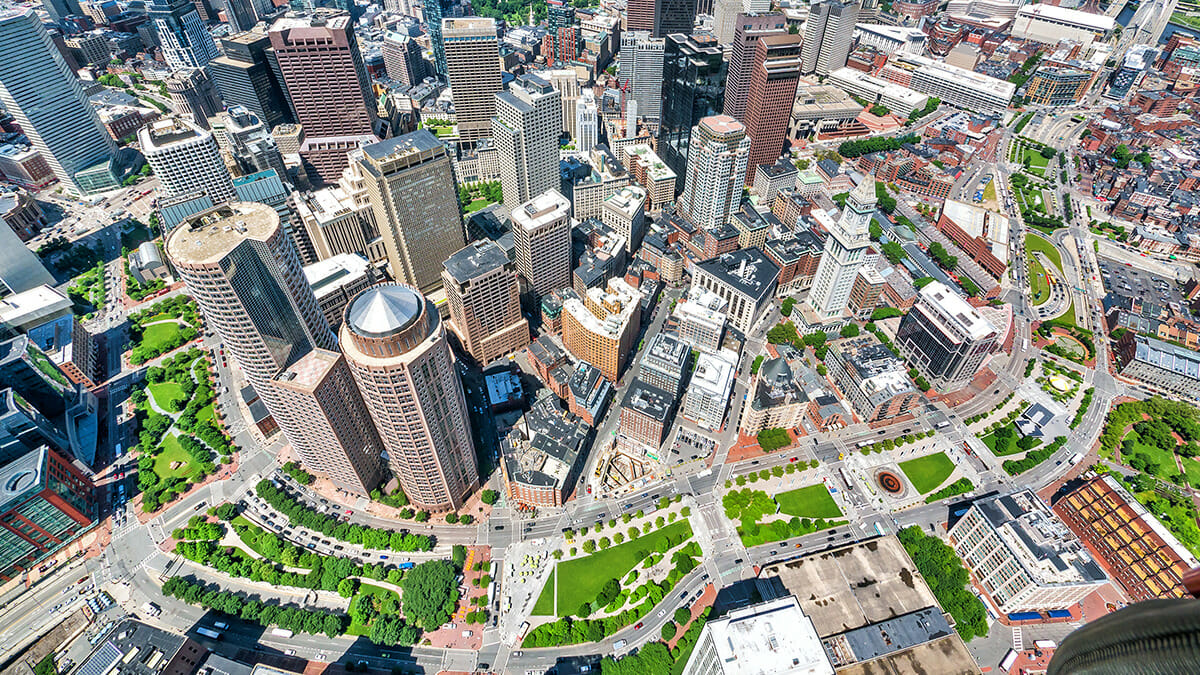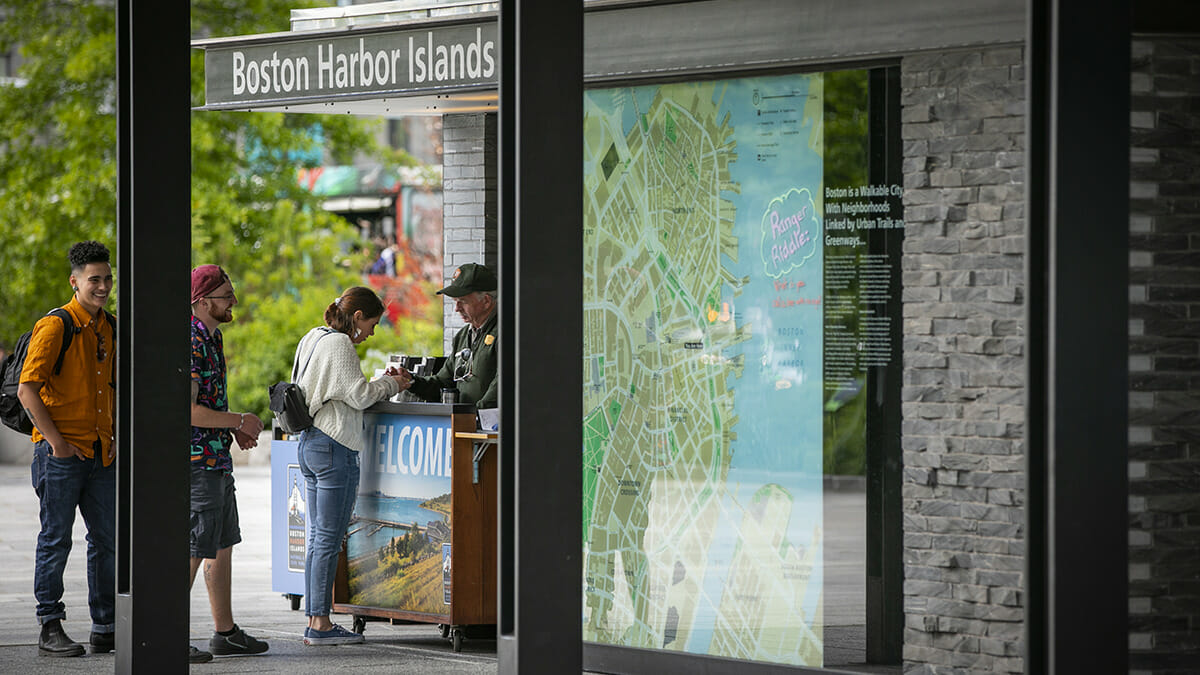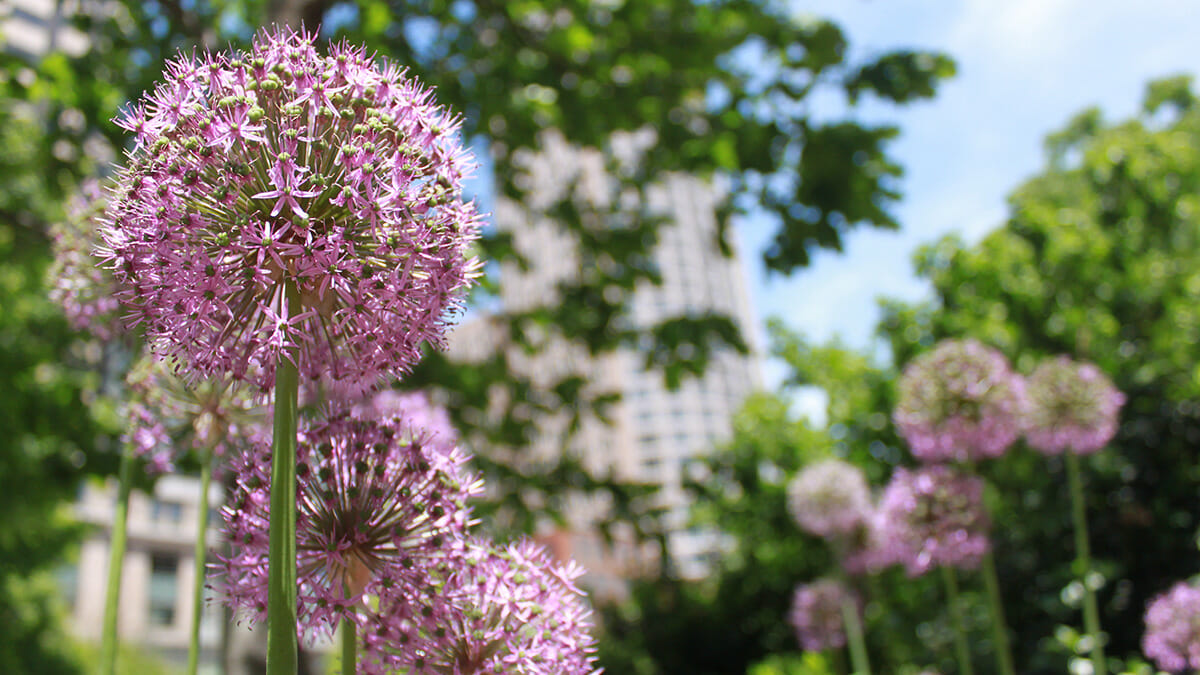Parks as Critical Infrastructure

Greenway Aerial. (Rose Fitzgerald Kennedy Greenway Conservancy/ Kyle Klein Photography)
By Cheri Ruane
Parks and open spaces are often conceived of as civic amenities, enriching their communities by providing places to gather, recreate, relax, and connect with nature. However, they are so much more than simply beautiful places – they can function as performative landscapes providing critical services that mitigate the effects of climate change while enhancing public health and wellness, especially in times of crisis.
With so many urgent needs competing for capital dollars, it is easy to understand how parks can be considered a “luxury.” People understand there’s urgency around having electricity, operational plumbing, and clean drinking water. By comparison, safe and inclusive places to participate in civic life seem less acute. But common open spaces are not luxuries, they are a vital part of a functioning society. By improving livability and resiliency, and supporting the sense of place in neighborhoods, they serve to support vibrant communities while also attracting businesses and local job growth. Parks help address critical infrastructure for public health issues and are recognized as a powerful tool to support modern cities and towns.
What is infrastructure and why should parks be included?
Infrastructure typically refers to the basic systems and services that a society needs to function. On a national level, it includes all the physical systems such as transportation networks, utilities, sewage, water, cell towers, and more, plus public services including those that support health, safety, welfare, and education. The Department of Homeland Security says, “Critical infrastructure describes the physical and cyber systems and assets that are so vital to the United States that their incapacity or destruction would have a debilitating impact on our physical or economic security or public health or safety. The nation’s critical infrastructure provides the essential services that underpin American society.”
These infrastructure systems, which require large initial investments, are essential for supporting quality of life and are considered a “public good.” A public good typically implies it’s provided to everyone equally, and usually paid for by the government through taxes, though this is not always the case.
While many agree parks are a “public good,” the lack of understanding around the significant impact these common spaces have on our lives allows them to be compromised and deprioritized when competing with public safety and healthcare. The irony is that studies from NRPA, APA, and NC State have shown an increase in public safety and general health when there is reliable and equitable access to public parks and open spaces. In the City Parks Forum Briefing Paper titled “How Cities Use Parks to Create Safer Neighborhoods” by American Planning Association these key points are worth noting:
- Time spent in nature immediately adjacent to home helps people relieve mental fatigue, reducing aggression.
- Green spaces are gathering places where neighbors form social ties that produce stronger, safer neighborhoods.
- Derelict or barren spaces are perceived as frightening and are more crime-prone than well-maintained parks.
The Environmental Impact of Parks
Parks have the ability to juggle several civic infrastructure systems. In addition to the health and safety benefits listed above, parks can mitigate floods and other natural disasters through resilient design strategies. City parks can be designed to act like sponges, holding water during rain events and slowly filtering stormwater after the event has passed. Cities use the natural capacity of green infrastructure to complement the traditional alternative of building and maintaining large underground networks of pipes and tunnels. Parks do this while improving air quality, reducing the heat-island effect, and creating close-to-home opportunities for outdoor recreation and experiences with nature.
Waterfront parks have an even bigger opportunity to protect neighborhoods by defending against sea level rise. At the 4.5-acre Langone Park and Puopolo Playground in Boston’s North End, the city implemented its first resilient design for public open space. Based on the Climate Ready Boston report released in 2016 the site was reimagined to protect and accommodate the rising tides, mitigate wave action, and recover easily from inundation. The park is an active outdoor recreation haven for the city’s most densely developed community and an important link within Boston’s Harborwalk, a network of publicly accessible corridors that provide the interface between public and private properties and access to Boston Harbor. By taking advantage of the outdoor recreational opportunities that the facility provides, combined with several engineered improvements to its ability to deflect and absorb the impacts of sea level rise, the neighborhood’s residents and many others will benefit from a stronger stance against the impacts of climate change. At the same time, it also can be a resource for physically distanced recreation during the pandemics that will follow COVID-19.

Ticket counter for Boston Harbor Islands with patrons waiting in line. Large scale map of the Boston waterfront to the left of the ticket counter. Rose Fitzgerald Kennedy Greenway Conservancy.
Atlanta has created the Atlanta BeltLine, a network of parks, trails and open spaces that include robust transportation options and stormwater management strategies. The 22-mile loop around the city connects communities and residents, while the parks along the BeltLine are engineered to manage stormwater and improve resilience to flooding risks. The original mind behind the proposal is Ryan Gravel, who was a graduate student in architecture and city planning at Georgia Tech in 1999 when he conceived the idea that was later implemented with the support of Perkins and Will. At the same time, Houston is improving resilience to flooding through the revitalization of Buffalo Bayou Park. Designed by SWA, the 160-acre linear park links a network of trails, open space, and public art while managing stormwater runoff, especially after major storm events.
City Parks for Health
Beyond the physical infrastructure challenges, cities are also facing our national health crisis. Health inequities result from chronic issues of environmental justice in all its forms. While the COVID-19 pandemic exposed systemic flaws in the public health infrastructure of the United States, it also exposed stark inequities in access to healthy environments, and how people are policed within what open spaces are available to them. This continues to be a growing threat specific to the health of communities of color. Addressing health disparities in cities requires a more equitable parks policy. To support this goal, the health benefits of parks need to be considered alongside the critical infrastructure services they provide, services increasingly important under social instability.
Infectious disease experts predict that epidemics are projected to increase in severity and frequency. Climate change will continue to endanger our most vulnerable communities at a disproportionate rate. One aspect of making common spaces truly inclusive will involve developing flexible infrastructure to accommodate serious health challenges and envisioning public park systems that are more agile in the holistic support of public health for all.

Park with city skyline in the background. Adults and children having picnics and playing in the water fountain at the park. (Photo/Rose Fitzgerald Kennedy Greenway Conservancy)

Pale purple Allium with trees and city buildings in the background. (Photo/Rose Fitzgerald Kennedy Greenway Conservancy)
On good days, this includes designing and maintaining big parks and greenways with ample walking, biking, and running trails that extend into all parts of the city, with a particular focus on historically underserved populations. Based on the cross-section of worldwide research, we know that these improvements will help people focus, improve mood and cognitive function, reduce anxiety, help people recover from stress, and help young people build social skills. We must embrace the opportunity to curate safe enjoyment of our common spaces.
Many professionals, educators, and scholars quickly noted and wrote about the importance of green space during the pandemic. One particularly well-curated piece on Medium, “Urban Parks as Critical Infrastructure: Equity and Access during Covid-19,” highlights the fact that it’s not all about the big parks. “Smaller green spaces provide a range of social and ecological benefits as well, and may be integrated into the urban fabric in a less transformative manner. Creating pocket parks, and greener and more multi-functional streetscapes encourages people to exercise and get fresh air while practicing social distancing. These types of initiatives can be found around the globe, with cities in the United States and Europe opening streets to restaurants and bars and expanding pedestrianized areas. Cities may empower neighborhoods to develop green spaces through community block grants, and through even simpler measures like providing a patch of soil and having the gardeners who happen to live there grow what they feel is right.”
Our common space networks must also be reimagined to support social justice. More than a public forum for protest, these spaces must feel safe in ways that include access and also use by populations that are fearful of racial profiling. The murder of Ahmaud Arbery, who was jogging, and the harassment of Christian Cooper, birdwatching in Central Park, painfully remind us that equal “access” is not enough. For open and green spaces in cities to fully serve diverse communities, we must consider and address these threats to communities of color, including expecting diverse uses of parks and putting in place policies to safeguard the lives of people of color in all common spaces.
Organizations like the National Recreation and Parks Association (NRPA) believe that “our nation’s public parks and recreation services should be equally accessible and available to all people regardless of income level, ethnicity, gender, ability, or age.” Their work continues to support initiatives that will ensure universal equity and social justice in parks across the county. Golden Gate National Parks Conservancy goes even further stating “We condemn anti-Black racism and are allies for equality in our parks and communities.”
Approaches for Equitable Common Space Networks
Another key aspect of parks as critical infrastructure is their ability to promote social cohesion and community engagement. Parks provide a public space where people of different backgrounds can come together, interact, and form connections. They can serve as a safe space where community members can come together to discuss issues, plan events, and build relationships. This can be especially important in areas where there may be a lack of other common spaces or opportunities for community engagement. The very nature of their outdoor positioning allows them to be less encumbered by preconceived notions associated with buildings. Public buildings owned by the government can feel unsafe, as can places of worship.
In order to be truly “common” parks and open spaces must be equitable, and we must ensure they serve the needs of diverse communities. Linking large and small parks to dense urban neighborhoods through green corridors encourages equitable use of parks and generally increases use. By networking corridors and complete streetscapes in areas without parks where alternative transit connections are lacking, cities will begin to address issues of unequal access to parks.
Emerging Equitable Funding Strategies and Tools
Many of these common space efforts leverage multiple sources of funding from federal, state, local, philanthropic, and private sector sources. City Parks Alliance has commissioned two reports. The first, “Investing in Equitable Urban Park Systems: Emerging Strategies and Tools,” is part of a national initiative to help cities understand various sources of funding and the additional implications each can have on communities, specifically related to equity. Urban Institute led the research and published the report, which explores twenty funding models and their equity considerations in cities of various sizes across the country. This work is made possible with support from the Robert Wood Johnson Foundation.
The second, “City Parks, A Smart Investment for America’s Health, Economy & Environment” is a series of 11 case studies highlighting the impacts of common spaces across the country. The Greenway Conservancy, a non-profit managing entity for the Rose Kennedy Greenway in Boston, saw the abutting properties benefited greatly from their proximity to this ribbon of open space and were able to negotiate a Business Improvement District (BID) to support the care of the park. BID contributions are financed through an elective tax that is applied to parcels within a one-block radius of the park site itself. In this case, the BID provides $1.5 million in funding each year.
Conclusion
As globalization continues its steady march into our collective experiences, it is becoming increasingly important to find places where we can feel embodied and grounded in our own context. Public parks and open green spaces are critical resources and must be considered a vital part of the infrastructure that supports our human existence. Where else in our built environment can we find a forum for social, mental, and physical connection that can be identified as common? These are places to be nurtured, supported, and elevated as an inalienable human right. From parks professionals to community organizations, and from government funding to private equity, a new recognition is necessary to ensure these common spaces not only survive but thrive in the face of our collective uncertainty.
